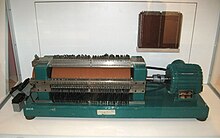This article needs additional citations for verification. (September 2012) |


BESK (Binär Elektronisk SekvensKalkylator, Swedish for "Binary Electronic Sequence Calculator") was Sweden's first electronic computer, using vacuum tubes instead of relays. It was developed by Matematikmaskinnämnden (Swedish Board for Computing Machinery) and for a short time it was the fastest computer in the world. The computer was completed in 1953[1][2][3] and in use until 1966. The technology behind BESK was later continued with the transistorized FACIT EDB and FACIT EDB-3 machines, both software compatible with BESK. Non-compatible machines highly inspired by BESK were SMIL made for the University of Lund, SAABs räkneautomat SARA, "SAAB's calculating machine", and DASK made in Denmark.
BESK was developed by the Swedish Board for Computing Machinery (Matematikmaskinnämnden) a few years after the mechanical relay computer BARK (Binär Aritmetisk Relä-Kalkylator, Swedish for "Binary Arithmetic Relay Calculator"). The team was initially led by Conny Palm, who died in December 1951, after which Stig Comét took over. The hardware was developed by Erik Stemme. Gösta Neovius and Olle Karlqvist were responsible for architecture and instruction set. It was closely modeled on the IAS machine for which the design team had retrieved drawings during a scholarship to Institute for Advanced Study (IAS) and Massachusetts Institute of Technology, U.S.
During the development of the BESK magnetic drum memory, Olle Karlqvist discovered a magnetic phenomenon, which has been called the Karlqvist gap.
- ^ Cortada, James W. (2012-09-27). The Digital Flood: The Diffusion of Information Technology Across the U.S., Europe, and Asia. OUP USA. p. 177. ISBN 9780199921553.
- ^ Impagliazzo, John; Lundin, Per; Wangler, Benkt (2011-09-29). History of Nordic Computing 3: Third IFIP WG 9.7 Conference, HiNC3, Stockholm, Sweden, October 18-20, 2010, Revised Selected Papers. Springer Science & Business Media. p. 426. ISBN 9783642233142.
- ^ "COMPUTERS, OVERSEAS: 1. Besk (Swedish Board For Computing Machinery, Stockholm, Sweden)". Digital Computer Newsletter. 7 (3): 10. Jul 1955.[dead link]